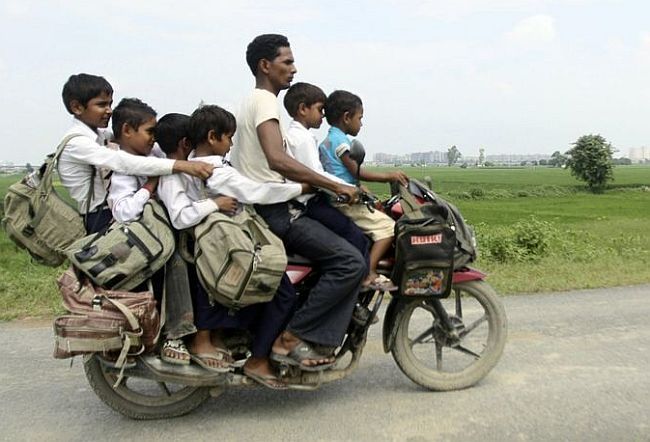
Many, if not most, observers of the Indian economy see 2015 as a year of decisive and positive movement.
Malcolm Gladwell's concept of the tipping point is used by some as a characterisation of the moment.
A number of forces converge to create a significant and discontinuous change, in this case, for the better.
The investment bank Nomura, for example, sees 2015 as a Goldilocks moment for India, a term used in astronomy to describe a situation in which conditions are "just right" for the emergence of life on a planet.
In this view, conditions that are supportive of a steady and sustainable acceleration of growth are falling into place. As we look ahead to 2015 and beyond, it is useful to look back; in particular to two possibly similar moments in the Indian economy's timeline.
Since 1991, we have seen two growth spurts - 1994-1997, when the average rate of growth was over seven per cent and 2003-08, when it came close to nine per cent.
Both episodes offer valuable lessons about what mix of conditions supports rapid growth in India and how changes in the mix can cause growth to slow.
In the first episode, a favourable backdrop was provided by nine successive normal monsoons (1988-96), which generated rural demand and contributed to keeping inflation in check.
The reforms of 1991 opened up massive investment opportunities as a result of de-licensing. Investment spending boomed, stimulating growth.
And the significant depreciation in the rupee that the reform strategy engineered caused a boom in exports, to which information technology (IT) was just beginning to contribute during that period.
But the party was over almost as soon as it had begun. A bad monsoon in 1997 was a setback.
The East Asian crisis saw the currencies of many competing exporters depreciate very sharply, impacting exports.
And inflation surged, partly demand-driven but also as a result of investment imbalances exerting pressure on capacities in many sectors, including infrastructure.
Growth fell back to around the five per cent mark for the next five years, raising serious questions about the economic benefits of the entire reform agenda.
Things changed in 2003.
Here again, it is possible to identify a number of pre-conditions and concomitants that featured in that five-year phase. Low inflation, supported by soft global commodity prices, were clearly a factor. There was also the tailwind provided by buoyant global growth.
These contributed to an investment surge, which appeared to be much more balanced than in the previous episode. An important contributor to this was the role of public investment.
Capital spending as a share of total government spending at the central level rose to a post-liberalisation high of 23 per cent during this period.
The most visible manifestation of this was the National Highway Development Programme, initiated in 2001, which had a classic public expenditure multiplier effect on the economy. Further, committed public investment also helped to facilitate an increase in private investment.
This, together with significant increases in productivity, which businesses struggling in a period of sluggish growth had achieved, brought about a dramatic increase in capital efficiency.
A factor that played a decisive role was the rapid growth in telecom capacity and capability.
For a while, it helped offset other infrastructural bottlenecks. Conference calls and e-mailing was possible even when stuck in endless traffic jams or airport congestion.
This fiscal pattern was facilitated by the larger commitment to fiscal consolidation reflected in the Fiscal Responsibility and Budget Management Act of 2003.
India's experience during the 2003-08 episode demonstrates that high growth can be achieved even as the fiscal deficit is being rolled back, as long as a greater proportion of expenditure is being used to create assets. In my view, this didn't go far enough, but even at the levels attained, the benefits were visible.
The final contributor to the Goldilocks phase was the balance of payments. IT and IT-enabled services exports grew rapidly, helping to narrow the current account deficit, even taking it to surplus in three of those years.
However, as in the previous episode, headwinds began to manifest during the growth spurt itself. Inflation became a problem, aggravated by surging commodity - particularly oil - and food prices.
The financial crisis of 2008 created adverse global conditions, weakening some of the growth drivers that the economy had benefited from earlier.
There was, of course, a short-lived recovery after the crisis, but this was based on the monetary and the fiscal response to the crisis, rather than the more robust force of private investment, which was decelerating. Significantly, the share of public expenditure allocated to capital formation has declined considerably from its peak.
The current account deficit ballooned to an unprecedented 4.8 per cent of gross domestic product, a result of a number of factors, including the massive increase in coal imports for electricity generation.
Be that as it may, many things have changed in the economic environment in 2014, both globally and domestically.
The robust United States recovery and significantly lower oil prices bring back into play tailwinds similar to 2003.
The latter helps considerably in narrowing both fiscal and current account deficits.
Inflation has moderated significantly, as a result of slow growth and less pressure from food and energy prices.
But it is still too early to invoke tipping points and Goldilocks conditions. Two factors that might spoil the party are the state of infrastructure and, related to this in part, the state of the banking system.
The first calls for a return to an increased role for public spending on infrastructure, along the lines of the highway programme in its initial stages.
Relying predominantly on private capital for infrastructure has proved to be infeasible. The second requires a substantial restructuring of bank balance sheets, with, possibly, a large capital infusion as part of the package.
Both are going to be fiscally costly, and politically and administratively challenging. The thing about tipping points and Goldilocks conditions is that they don't emerge overnight.
Lots of things have to fall into place, many out of the government's control. The first episode came three years after liberalisation and lasted three years.
The second came six years later and lasted five. Patience and persistence are key to achieving them and even they don't guarantee sustainability.
Regardless, it is incumbent on the government to keep trying.
Subir Gokarn is director of research, Brookings India, and former deputy governor, RBI. These views are his own










